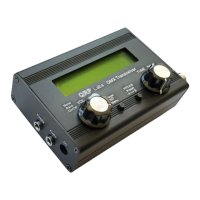Tips for a successful build:
1. READ the manual, and every instruction carefully! Don’t try to be a hero (proceed without
reading carefully). There are many more people who will need to buy a new board, than
real heroes…
2. Don’t rush! Take your time!
3. Use good lighting!
4. Use a jeweler's loupe to check component values of capacitors BEFORE soldering.
5. Use a soldering iron with a fine tip and high power. For example 60W
6. When soldering capacitors (and other components), note that where pins are grounded,
these typically need a lot more heat to ensure a good clean joint. A common error is poorly
soldered ground connections of LPF capacitors, which causes incorrect filter performance
(often manifested as low power output).
7. When soldering and clipping component leads, be very careful of nearby SMD components
which could easily be damaged. Before soldering/clipping, identify nearby SMDs, then
make sure that you approach the lead to be soldered or clipped from the opposite direction
to the nearby SMD component.
8. KEEP the component lead offcuts from the capacitors – they are used later when installing
the LCD module.
9. Solder connectors with no more heat and time necessary to create a good solid clean joint
to avoid melting the plastic body parts of the connectors.
10.Remember diodes MUST be connected the correct way round!
11.After every joint, inspect with the jeweler's loupe to check for a good clean joint and any
solder bridges to any nearby components: a lot of the components are packed very close
together.
12.Clip all components leads as short as possible to avoid any shorts to the enclosure on the
underside of the board.
13.Install all connectors square and well-seated on the boards, to ensure when the boards are
plugged together and installed in the enclosure, everything fits properly.
14.Don’t forget: QMX is supplied without firmware. Therefore at first power-up, you
must install the latest firmware, a very simple procedure which is described in
section 2.32.
2.2 PCB diagrams (trace, component identification)
Subsequent pages show the trace and component identification diagrams for the various QMX
PCBs.
QMX assembly Rev 1.00e 9

